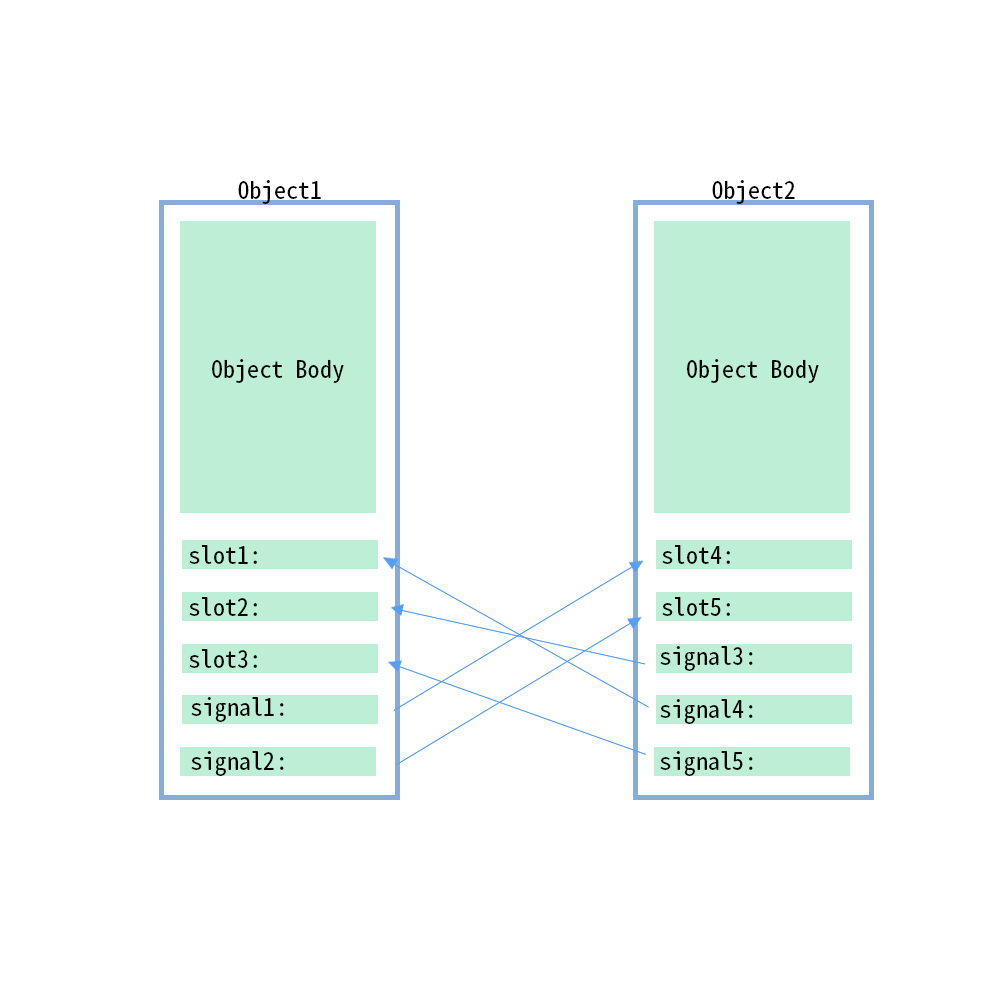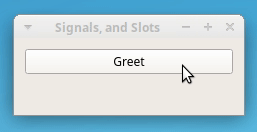- No drama:) msg = 'This slot was manually connected, and is called once' self. Append (msg) def onbrokenbtnclicked (self): ' This slot is connected automatically in connectSlotsByName ' # connectSlotsByName found this handler - it starts with on, followed # by the object name, followed by the signal this should be connected # to.
- Is the signal-slot connection automatically disconnected when the python object is garbage collected? So, assuming that an instance of Example has no more references, and it gets garbage collected, does the signal-slot connection get disconnected? Are there other caveats to be aware of here? What if Example were a subclass of QObject?
- Video 17 - In the videos so far we've gotten pretty familiar with the Signal/Slot mechanism in Python Qt framework. Today we're introducing the so-called new syntax, which is much more pythonic.
- Qt For Python Signal Slot
- Signal Slot Qt Python Tutorial
- Python Qt Signal Slot
- Signal Slot Qt Python Program
- Signal Slot Qt Python Example
Released:
Today, we're going to discuss the Python/Qt way of allowing your application to respond to user-triggered events: signals and slots. When a user takes an action — clicking on a button, selecting a value in a combo box, typing in a text box — the widget in question emits a signal. Bool connect (QObject, SIGNAL, callable, Qt.ConnectionType = Qt.AutoConnection) The first argument is the name of the object that is emitting the signal. The second argument is the signal, and the third argument is the slot. The slot has to bee a python callable object.
A QT signal/slot concept for Python with Weakrefs.

Project description
QSignal – A QT Signal/slot for python
This project provides easy to use Signal class for implementing Signal/Slot mechanism in Python.It does not implement it strictly but rather creates the easy and simple alternative.
Classes
Signal
qsignal.Signal is the main class.
To create a signal, just make a sig = qsignal.Signal When can you increase your bet in blackjack. and set up an emitter of it. Or create it withsig = qsignal.Signal(emitter=foo).
To emit it, just call your sig().Or emit it in asynchronous mode with the method async.
Example:
To connect slots to it, pass callbacks into connect. The connections are maintained through weakref, thusyou don't need to search for them and disconnect whenever you're up to destroy some object.
Signaller
The base class for objects to maintain their Signals.
The only purpose of this class is to automate Signal names and emitter references.
Release historyRelease notifications | RSS feed
1.0.2b1 pre-release When do you raise your bet in blackjack.
1.0.1b1 pre-release
1.0.0b1 pre-release
Download files
Download the file for your platform. If you're not sure which to choose, learn more about installing packages.
| Filename, size | File type | Python version | Upload date | Hashes |
|---|---|---|---|---|
| Filename, size qsignal-1.0.2b1-py2.py3-none-any.whl (6.7 kB) | File type Wheel | Python version py2.py3 | Upload date | Hashes |
| Filename, size qsignal-1.0.2b1.tar.gz (7.5 kB) | File type Source | Python version None | Upload date | Hashes |
Qt For Python Signal Slot
CloseHashes for qsignal-1.0.2b1-py2.py3-none-any.whl
| Algorithm | Hash digest |
|---|---|
| SHA256 | 12f758d84e543bfc209fba81365a2777039a457d25427253996b0fb83d14ee1c |
| MD5 | 2a5fba356eb42d102b13290a0116ccea |
| BLAKE2-256 | bc7aa17c3e2517a52c9fb76dd3239a12c5f03f32052efb040acbb324f0c6a178 |
Signal Slot Qt Python Tutorial
Hashes for qsignal-1.0.2b1.tar.gz
| Algorithm | Hash digest |
|---|---|
| SHA256 | 603607c0a1ef0b050a5b8806793c1b203c74d34da9815fe87b17a7bf30f8c1ce |
| MD5 | a749546330b4da579a18f0fa6fa86d33 |
| BLAKE2-256 | 25f6876034a74406da8b5d40a30e8a9afefd4ceb050bda691e5c4016b4428dac |
last modified July 16, 2020
In this part of the PyQt5 programming tutorial, we explore events and signalsoccurring in applications.
Events in PyQt5
GUI applications are event-driven. Events are generated mainly by theuser of an application. But they can be generated by other means as well; e.g. anInternet connection, a window manager, or a timer.When we call the application's exec_() method, the application entersthe main loop. The main loop fetches events and sends them to the objects.
In the event model, there are three participants:
- event source
- event object
- event target
The event source is the object whose state changes. It generates events.The event object (event) encapsulates the state changes in the event source.The event target is the object that wants to be notified. Event source objectdelegates the task of handling an event to the event target.
PyQt5 has a unique signal and slot mechanism to deal with events.Signals and slots are used for communication between objects. A signalis emitted when a particular event occurs. A slot can be any Python callable.A slot is called when its connected signal is emitted.
Python Qt Signal Slot
PyQt5 signals and slots
This is a simple example demonstrating signals and slots in PyQt5.
In our example, we display a QtGui.QLCDNumberand a QtGui.QSlider. We change the lcdnumber by dragging the slider knob.
Here we connect a valueChanged signal of the slider to thedisplay slot of the lcd number.
The sender is an object that sends a signal. The receiveris the object that receives the signal. The slot is the method thatreacts to the signal.
PyQt5 reimplementing event handler
Events in PyQt5 are processed often by reimplementing event handlers.
In our example, we reimplement the keyPressEvent() event handler.
If we click the Escape button, the application terminates.
Event object in PyQt5
Event object is a Python object that contains a number of attributesdescribing the event. Event object is specific to the generated eventtype.

Project description
QSignal – A QT Signal/slot for python
This project provides easy to use Signal class for implementing Signal/Slot mechanism in Python.It does not implement it strictly but rather creates the easy and simple alternative.
Classes
Signal
qsignal.Signal is the main class.
To create a signal, just make a sig = qsignal.Signal When can you increase your bet in blackjack. and set up an emitter of it. Or create it withsig = qsignal.Signal(emitter=foo).
To emit it, just call your sig().Or emit it in asynchronous mode with the method async.
Example:
To connect slots to it, pass callbacks into connect. The connections are maintained through weakref, thusyou don't need to search for them and disconnect whenever you're up to destroy some object.
Signaller
The base class for objects to maintain their Signals.
The only purpose of this class is to automate Signal names and emitter references.
Release historyRelease notifications | RSS feed
1.0.2b1 pre-release When do you raise your bet in blackjack.
1.0.1b1 pre-release
1.0.0b1 pre-release
Download files
Download the file for your platform. If you're not sure which to choose, learn more about installing packages.
| Filename, size | File type | Python version | Upload date | Hashes |
|---|---|---|---|---|
| Filename, size qsignal-1.0.2b1-py2.py3-none-any.whl (6.7 kB) | File type Wheel | Python version py2.py3 | Upload date | Hashes |
| Filename, size qsignal-1.0.2b1.tar.gz (7.5 kB) | File type Source | Python version None | Upload date | Hashes |
Qt For Python Signal Slot
CloseHashes for qsignal-1.0.2b1-py2.py3-none-any.whl
| Algorithm | Hash digest |
|---|---|
| SHA256 | 12f758d84e543bfc209fba81365a2777039a457d25427253996b0fb83d14ee1c |
| MD5 | 2a5fba356eb42d102b13290a0116ccea |
| BLAKE2-256 | bc7aa17c3e2517a52c9fb76dd3239a12c5f03f32052efb040acbb324f0c6a178 |
Signal Slot Qt Python Tutorial
Hashes for qsignal-1.0.2b1.tar.gz
| Algorithm | Hash digest |
|---|---|
| SHA256 | 603607c0a1ef0b050a5b8806793c1b203c74d34da9815fe87b17a7bf30f8c1ce |
| MD5 | a749546330b4da579a18f0fa6fa86d33 |
| BLAKE2-256 | 25f6876034a74406da8b5d40a30e8a9afefd4ceb050bda691e5c4016b4428dac |
last modified July 16, 2020
In this part of the PyQt5 programming tutorial, we explore events and signalsoccurring in applications.
Events in PyQt5
GUI applications are event-driven. Events are generated mainly by theuser of an application. But they can be generated by other means as well; e.g. anInternet connection, a window manager, or a timer.When we call the application's exec_() method, the application entersthe main loop. The main loop fetches events and sends them to the objects.
In the event model, there are three participants:
- event source
- event object
- event target
The event source is the object whose state changes. It generates events.The event object (event) encapsulates the state changes in the event source.The event target is the object that wants to be notified. Event source objectdelegates the task of handling an event to the event target.
PyQt5 has a unique signal and slot mechanism to deal with events.Signals and slots are used for communication between objects. A signalis emitted when a particular event occurs. A slot can be any Python callable.A slot is called when its connected signal is emitted.
Python Qt Signal Slot
PyQt5 signals and slots
This is a simple example demonstrating signals and slots in PyQt5.
In our example, we display a QtGui.QLCDNumberand a QtGui.QSlider. We change the lcdnumber by dragging the slider knob.
Here we connect a valueChanged signal of the slider to thedisplay slot of the lcd number.
The sender is an object that sends a signal. The receiveris the object that receives the signal. The slot is the method thatreacts to the signal.
PyQt5 reimplementing event handler
Events in PyQt5 are processed often by reimplementing event handlers.
In our example, we reimplement the keyPressEvent() event handler.
If we click the Escape button, the application terminates.
Event object in PyQt5
Event object is a Python object that contains a number of attributesdescribing the event. Event object is specific to the generated eventtype.
In this example, we display the x and ycoordinates of a mouse pointer in a label widget.
The x and y coordinates are displayd in a QLabelwidget.
Mouse tracking is disabled by default, so the widget only receives mouse moveevents when at least one mouse button is pressed while the mouse is being moved.If mouse tracking is enabled, the widget receives mouse move events evenif no buttons are pressed.
The e is the event object; it contains data about the eventthat was triggered; in our case, a mouse move event. With the x()and y() methods we determine the x and y coordinates ofthe mouse pointer. We build the string and set it to the label widget.
PyQt5 event sender
Sometimes it is convenient to know which widget is the sender of a signal.For this, PyQt5 has the sender method.
We have two buttons in our example. In the buttonClicked methodwe determine which button we have clicked by calling thesender() method.
Both buttons are connected to the same slot.
We determine the signal source by calling the sender() method.In the statusbar of the application, we show the labelof the button being pressed.
PyQt5 emitting signals
Objects created from a QObject can emit signals.The following example shows how we to emit custom signals.
We create a new signal called closeApp. This signal isemitted during a mouse press event. The signal is connected to theclose() slot of the QMainWindow.
Signal Slot Qt Python Program
A signal is created with the pyqtSignal() as a class attributeof the external Communicate class.
Signal Slot Qt Python Example
The custom closeApp signal is connected to the close()slot of the QMainWindow.
When we click on the window with a mouse pointer, the closeApp signalis emitted. The application terminates.
In this part of the PyQt5 tutorial, we have covered signals and slots.